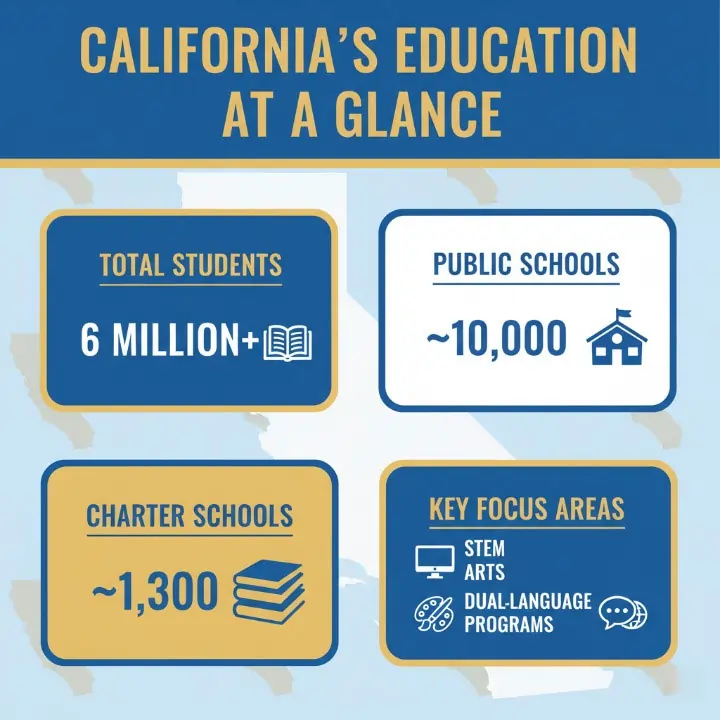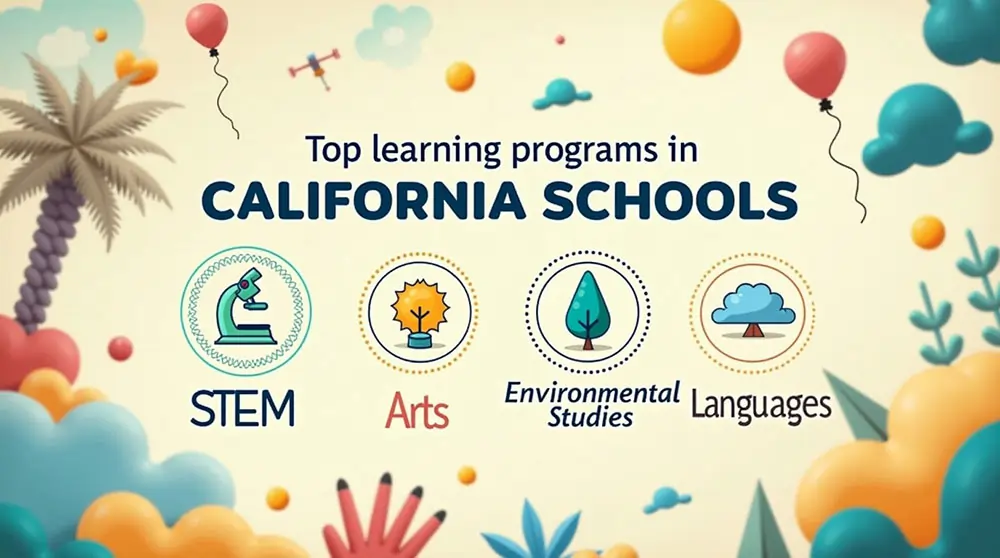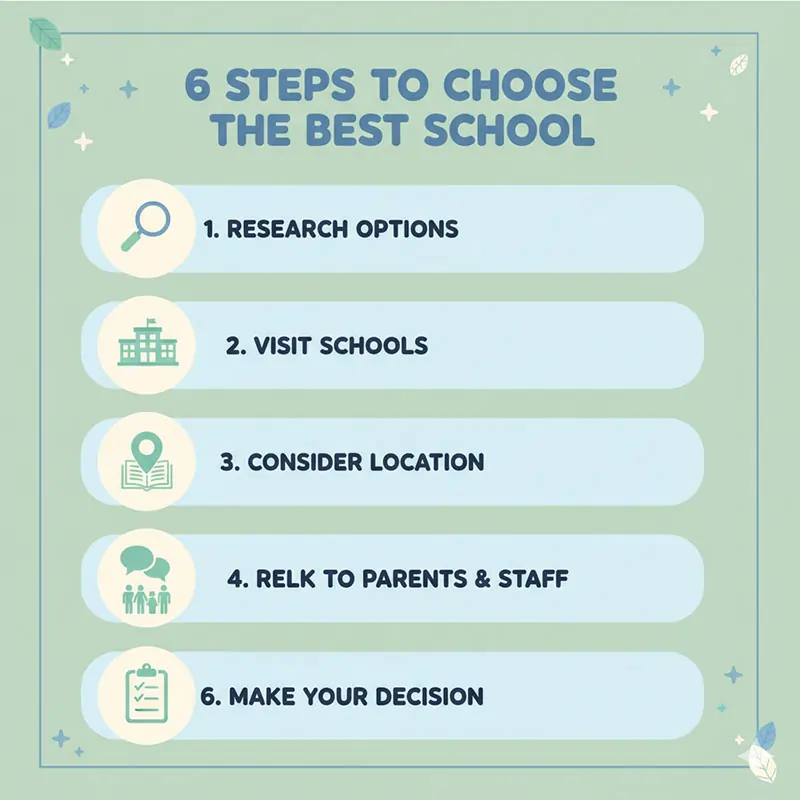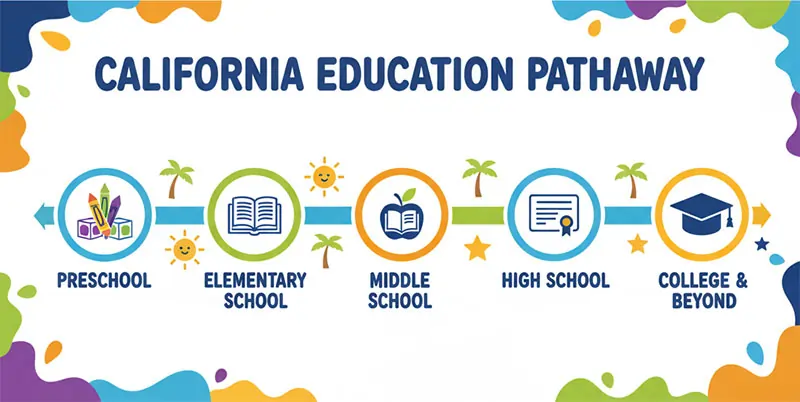California Schools: Top Schools, Programs, and Educational Opportunities
California is home to one of the most dynamic and diverse education systems in the United States. With over 6 million students enrolled in public schools and thousands more in private and charter institutions, the state offers endless opportunities for young learners to thrive.
1. Introduction – Overview of California’s Education System
Ever driven through California wondering why schools look so different from one town to the next? That’s intentional. Sort of.
Silicon Valley schools partner with Google and Apple for robotics programs. LA schools focus heavily on arts and entertainment industry connections. A rural district near Redding might have twenty kids per grade but access to environmental science programs urban schools envy. This state’s huge, diverse, and educational quality bounces all over the map.
People assume the best schools in California cluster in wealthy neighborhoods. Sometimes true. But I’ve seen exceptional programs in unexpected places—overlooked districts, small towns, schools that don’t make headlines but consistently turn out kids who genuinely love learning.
California officially emphasizes creativity, inclusion, and innovation. Reality check? That depends wildly on your district’s tax base and local priorities. But when schools here get it right—combining traditional academics with real-world learning—kids graduate prepared for futures their parents can barely imagine.
Your kid dreams of marine biology? There’s a coastal program for that. Video game design? Yep. Aerospace engineering? Obviously—this is California. The tricky part is finding which program actually delivers versus which just sounds good in the brochure.

2. Public vs Private Schools in California
This decision wrecks parents. I’ve watched friends agonize over it for months.
Public schools run on tax dollars—yours and your neighbors’. Free to attend, which matters hugely for most families. They follow state education standards, meaning curriculum consistency across districts. In theory. Actually, a public school in Palo Alto looks nothing like one in Fresno. Funding disparities create massive differences.
Some public schools genuinely rival elite private institutions. State-of-the-art facilities, specialized magnet programs, teachers who could work anywhere but choose public education. Others struggle with overcrowding, outdated textbooks, and teachers stretched impossibly thin. Same system. Completely different experiences.
Private schools do their own thing—unique philosophies, religious affiliations, experimental teaching methods. Tuition runs $8,000 to $40,000 yearly. Sometimes more for places where celebrity kids attend. That money typically buys smaller classes, individualized attention, and college counseling starting in ninth grade. Also sometimes just prestige and networking opportunities.
Here’s the breakdown parents actually care about:
| Criteria | Public Schools | Private Schools |
| Funding | Government-funded | Tuition and donations |
| Curriculum | State-mandated | Custom or specialized |
| Class Size | Larger (25–35 students) | Smaller (10–20 students) |
| Cost | Free | $8,000–$40,000/year |
| Examples | Palo Alto Unified, Los Angeles USD | Harvard-Westlake, The Harker School |
Here’s what nobody says out loud: neither choice guarantees success. Some kids flourish in big public schools with diverse populations and constant activity. Others desperately need the structure and quiet attention private schools provide. Your specific child matters more than general school quality.
3. Top-Ranked Elementary, Middle, and High Schools
California has schools that make national “best of” lists regularly. Academic powerhouses. College prep factories. Places where admission alone opens doors.
Rankings tell part of the story. They reveal test scores, college acceptance rates, advanced course offerings. They miss whether kids actually enjoy going there. Whether struggling students get help or just get left behind. Whether the pressure cooker environment creates achievement or anxiety.
Worth noting anyway because these schools ARE exceptional:
Top Elementary Schools
- Jack L. Weaver Elementary (Los Alamitos) – Academically rigorous without crushing little kids’ spirits. That balance is harder than it sounds.
- Murdock-Portal Elementary (Cupertino) – STEM focus where kindergartners code. Hands-on learning instead of worksheets. Kids actually building circuits and robots.
- Saratoga Elementary (Saratoga) – Arts-integrated curriculum in a wealthy district that actually funds those programs. Not just test prep disguised as education.
Top Middle Schools
- The Harker Middle School (San Jose) – Private, expensive, undeniably excellent. STEM meets arts. Kids learn violin while building apps.
- Granite Ridge Intermediate (Fresno) – Public school proving great education exists outside coastal wealth bubbles. Strong athletics, community involvement, students who care.
- Robert Frost Middle School (Granada Hills) – Language immersion creating bilingual kids who think in multiple languages. Gifted programs without elitism. Rare combination.
Top High Schools
- Henry M. Gunn High School (Palo Alto) – Advanced everything. Robotics teams winning national competitions. Also unfortunately known for intense academic pressure. Excellence costs.
- Harvard-Westlake School (Los Angeles) – Where entertainment industry kids and future Ivy Leaguers mix. Produces both. Access remains limited to wealthy families mostly.
- Torrey Pines High School (San Diego) – Science and entrepreneurship focus leveraging San Diego’s biotech scene. Coastal location inspiring marine biology programs.
4. Special Programs and STEM Opportunities
California’s tech industry influence shows up strongest in STEM programs. Schools partner with nearby companies and universities, giving kids access to resources most states can’t match.
Forget textbook learning. These programs involve kids solving actual problems, working on real projects, understanding how STEM careers actually function.
Programs Worth Knowing About:
- Project Lead The Way (PLTW) – Engineering and coding woven throughout curriculum. Not separate computer class—engineering thinking embedded everywhere. Kids approach problems differently after this.
- California Science Olympiad – Competitive science for kids who geek out over that stuff. Teams building devices, conducting experiments, racing against other science-obsessed students statewide.
- Early Robotics Programs – Harker and Gunn run nationally competitive robotics teams. Kids design, build, program, and troubleshoot complex machines. Failure teaches as much as success.
- Environmental Science Initiatives – Coastal schools obviously lean into marine biology. Kids studying tide pools, tracking whale migrations, understanding ecosystems firsthand instead of reading about them.
Beyond STEM, California schools increasingly emphasize arts, languages, and social sciences. Officially anyway. Budget reality? Arts get cut first when money tightens. Tech companies donate to STEM. Music programs disappear. Frustrating but true.
Understanding these dynamics helps parents advocate effectively for programs that matter.

5. Tips for Parents Choosing Schools in California
School choice keeps parents up at night. Makes sense—this decision affects daily happiness, social development, future opportunities. Pressure’s real.
✏️ What Actually Helps:
- Figure out YOUR priorities. Not what other parents value. What matters for your specific kid? Academic rigor? Arts programs? Inclusive environment? You can’t optimize everything. Pick your top three non-negotiables.
- Research beyond rankings. Check California School Dashboard for data. Then dig deeper. What’s teacher turnover rate? How does admin handle bullying? What do parents actually say when nobody’s selling you anything?
- Visit campuses during regular hours. Tours are fine. Better? Show up randomly midday. Watch teacher-student interactions. Notice whether kids seem engaged or checked out. Trust your gut about the vibe.
- Calculate actual commute times. That perfect school thirty minutes away? Test drive during morning rush hour. Then factor in afternoon pickups, evening activities, traffic. Distance affects participation, friendships, your sanity. Be realistic.
- Investigate extracurriculars thoroughly. Academic programs matter. So does what happens after 3pm. Does the school offer clubs matching your kid’s interests? Sports they want? Activities for discovering new passions?
- Talk to parents whose kids resemble yours. Not just any parents—parents of kids similar to yours in personality, learning style, challenges. Their experience predicts yours better than generic reviews.

6. FAQs About California Schools
1. What is the best school district in California?
Palo Alto Unified, Cupertino Union, San Marino Unified top most lists. But “best” depends on what you’re measuring. Best for high-achieving STEM kids? Probably those. Best for creative, kinesthetic learners? Maybe totally different districts nobody ranks highly.
2. Are California public schools free?
Yes. But watch for program fees, field trip costs, donation requests. “Free” has asterisks. Not remotely comparable to private tuition, but they exist.
3. How can I find the right school for my child?
Start with California School Dashboard or GreatSchools.org for objective data. Then investigate personally—campus visits, parent conversations, gut checks. Data provides starting points. Real investigation reveals fit.
4. What are magnet and charter schools?
Magnet schools specialize—STEM, arts, language immersion. Public but requiring applications. Often competitive admission. Charter schools operate independently with more flexibility than traditional public schools. Still publicly funded and free. Quality varies wildly. Some innovate brilliantly. Others underperform neighborhood schools dramatically.
5. Are private schools worth the cost?
Depends on your finances, your child’s needs, your public options. Private schools offer smaller classes and customized curriculum. Many California public schools—especially in well-funded districts—provide exceptional education without tuition. Expensive doesn’t automatically mean better. Sometimes it does. Sometimes it just means expensive.
7. Conclusion and Additional Resources
California’s education system leads nationally when properly funded and managed. Innovation, diversity, ambition—it’s all here. Finding it requires effort.

Parents shape outcomes by staying involved—not just choosing once but continuously evaluating, communicating with teachers, adjusting when necessary. What works in elementary might fail in middle school. Kids change. Schools change. Stay flexible.
California offers world-class educational opportunities. Accessing them requires research, campus visits, persistent questions, and sometimes fighting for what your child needs. That effort pays off for years.
For further exploration, here are some useful resources:
🔗 Additional Resources:
- California Department of Education (CDE) – Official policies and data
- California School Dashboard – School performance comparisons
- GreatSchools.org California Listings – Parent reviews
- STEM Learning Ecosystems in California – Specialized program info
Your child’s education matters enormously. Research thoroughly. Visit extensively. Ask persistently. The right school exists—finding it takes work worth doing.


